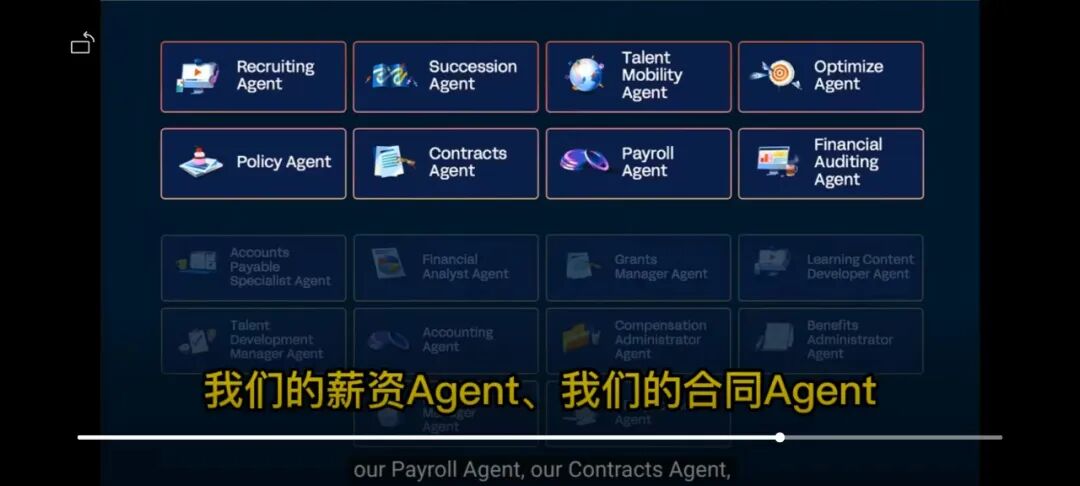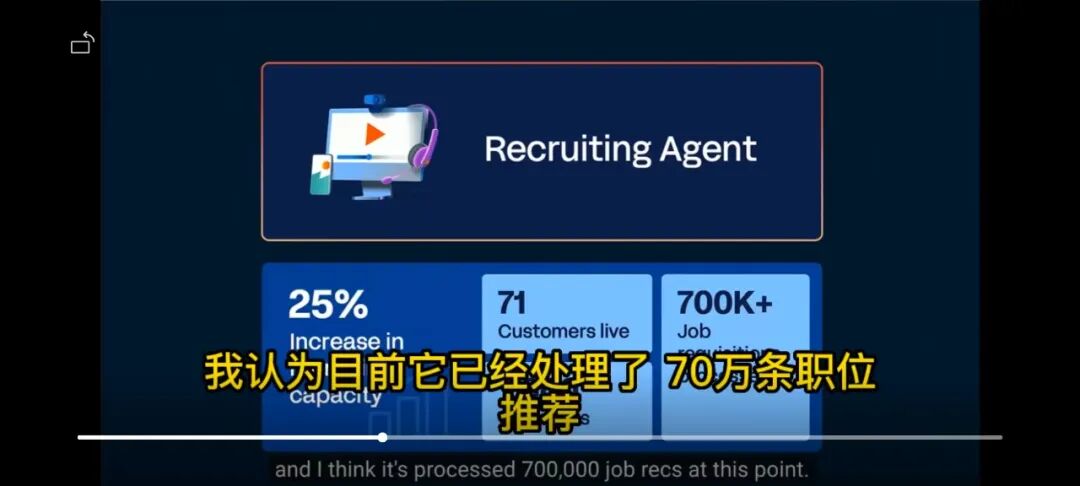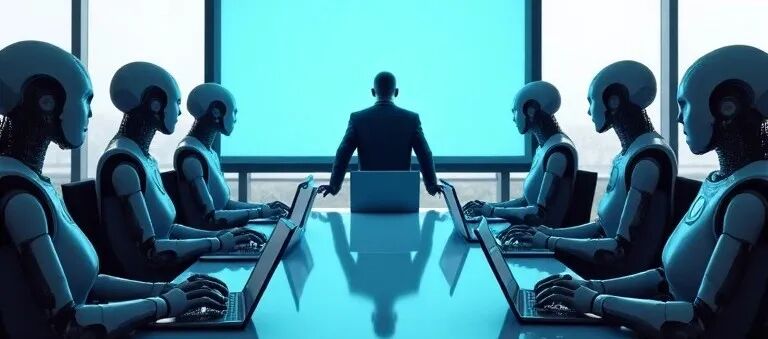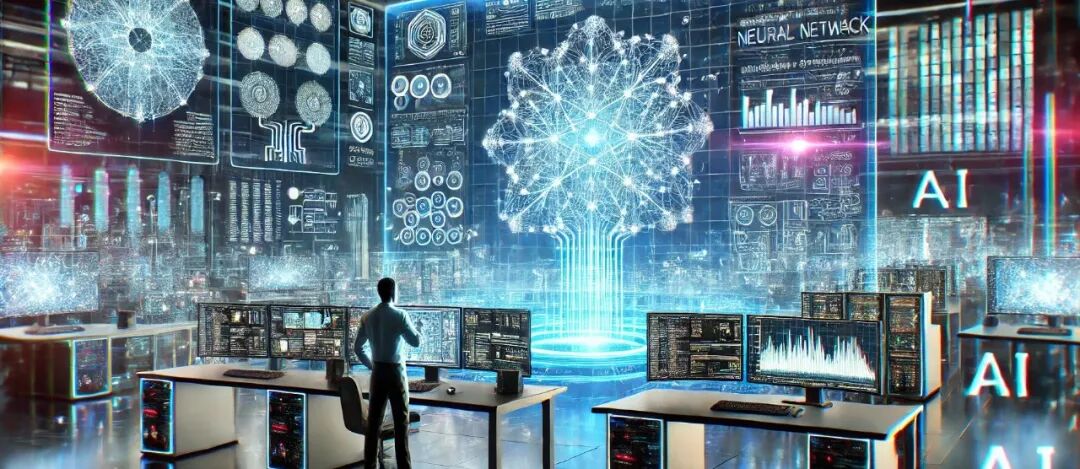1. From RPA to AI Agents: The Evolution of Digital Employees
1.1 The Era of Automation 1.0: The Birth and Limitations of RPA
In the wave of digital transformation, the pursuit of efficiency by enterprises has never ceased. In the early days, to address a large number of repetitive and highly regular tasks, RPA (Robotic Process Automation) emerged. RPA acts like a tireless “digital assistant,” simulating human operations on computers to automatically complete a series of tasks according to predefined rules, such as data entry, report generation, and document organization. For example, in financial institutions, manual reconciliation was not only time-consuming and labor-intensive but also prone to errors. After introducing RPA, robots could work 24/7, quickly and accurately completing reconciliation tasks, improving efficiency by 80%.
However, RPA also has significant limitations. It operates strictly within the confines of predefined rules and processes. When faced with scenarios requiring flexible judgment, complex decision-making, or handling unstructured data, RPA struggles. For instance, in cross-system data interactions, when complex logical judgments and decisions are involved between multiple systems, RPA cannot autonomously make reasonable choices and still requires human intervention. This is akin to a chef who can only follow recipes; when faced with a dish not included in the recipe, they are at a loss.
1.2 Intelligent Upgrade: The Fusion Breakthrough of RPA and AI
To overcome the limitations of RPA and enable digital employees to handle more complex tasks, the fusion of RPA and AI has become an inevitable trend. By incorporating AI technologies such as OCR (Optical Character Recognition) and NLP (Natural Language Processing), digital employees have gained enhanced perception and understanding capabilities, beginning to venture into the realm of unstructured data processing.
In the financial sector, processing invoice reimbursements used to be a cumbersome task requiring manual recognition of information on invoices and entry into systems. Now, with OCR technology, digital employees can quickly and accurately recognize text on invoices and automatically input it into financial systems, significantly improving processing efficiency and accuracy. In customer service scenarios, NLP technology enables digital employees to understand customers’ natural language inquiries and provide corresponding answers, achieving intelligent customer service functionality.
According to IDC data, the market size of RPA+AI in China reached $310 million in 2022, with an annual growth rate of 19.2%. In this market, many enterprises have emerged, with Jinzhihui leading the industry with a 10.9% market share due to its advanced technology and quality service, becoming a standout in the RPA+AI field. This fusion not only expands the application scenarios of digital employees but also brings greater value to enterprises.
1.3 The Ultimate Form of AI Agents: Autonomous Decision-Making and Hyper-Automation
With the rapid development of large model technology, AI Agents have gradually become the ultimate form of digital employees. Compared to traditional RPA and RPA+AI, AI Agents leverage the powerful reasoning, learning, and understanding capabilities of large models, enabling them to autonomously perceive their environment, dynamically plan tasks, and execute decisions, truly achieving a closed loop of “analysis – decision – execution.”
For example, the embodied intelligent guidance robot in government service halls can engage in natural interactions with citizens through multi-turn dialogues, deeply understanding their business needs. Based on this understanding, it can automatically invoke relevant business processes to complete transactions, achieving full-process automation from consultation to transaction. In this process, the AI Agent acts like an experienced government worker, flexibly responding to various complex business scenarios and providing efficient and convenient services to the public.
The emergence of AI Agents has transformed digital employees from simple task executors into intelligent decision-makers, ushering in a new era of hyper-automation. They not only significantly enhance work efficiency but also bring more innovation and transformation to enterprises and society.

2. The Three Core Advantages of AI Agent Digital Employees
2.1 Safe and Efficient: Building the Intelligent Foundation of Enterprises
In the digital age, enterprises’ demands for safety and efficiency have reached unprecedented heights. AI Agent digital employees, with their outstanding performance, have become a key force in building the intelligent foundation of enterprises.
Take Jinzhihui as an example; as a leading enterprise in the industry, it invests heavily in R&D, with R&D expenditure accounting for nearly 50%, continuously driving technological innovation. Its AI Agent digital employees achieve full-stack domestic adaptation, with every aspect from hardware to software meticulously refined to ensure system stability and compatibility. Moreover, Jinzhihui’s products have passed the 3+ level certification from the China Academy of Information and Communications Technology, which is an authoritative recognition of their product safety and reliability, providing a solid guarantee for the core data and business processes of enterprises.
In the field of financial risk control, the efficiency of AI Agent digital employees is fully demonstrated. Previously, financial institutions required substantial manpower and time for risk assessment and data analysis. Now, AI Agents can automatically collect, organize, and analyze vast amounts of data, quickly generating detailed data analysis reports. Statistics show that after introducing AI Agents, manual workload has decreased by 90%, significantly improving work efficiency while also reducing the risk of human error. This is akin to a well-trained special forces team that can swiftly and accurately complete tasks, providing strong support for enterprise decision-making.
2.2 Comprehensive Coverage of Scenarios: Unleashing Productivity Boundaries
AI Agent digital employees have a wide range of application scenarios, covering almost all areas of enterprise operations, including customer service, finance, supply chain, human resources, marketing, and more than 10 other fields. The AI “digital employee” product launched by New Guodu can generate different functional “digital employees” such as HR “digital employees,” design “digital employees,” and customer service “digital employees” based on the needs of various management modules by importing and training enterprise data, providing efficient operation solutions for enterprises and clients.
In the e-commerce industry, AI Agent digital employees can take on the role of intelligent customer service, answering customer inquiries online 24 hours a day, handling order inquiries, returns, and exchanges. Statistics show that AI customer service can handle over 80% of common issues, greatly improving customer service efficiency and satisfaction. In the finance sector, AI Agents can automatically complete accounting, invoice review, and tax declaration tasks, not only improving accuracy but also promptly identifying potential financial risks.
A report from Dongwu Securities indicates that AI digital employees can replace three basic employees with a monthly salary of 7,000, potentially saving enterprises 252,000 yuan annually. This means that enterprises can significantly reduce labor costs without compromising business quality, allowing the released human resources to be invested in more creative and valuable work, thus achieving a leap in productivity.

2.3 Human-Machine Collaboration: Restructuring Organizational Efficiency
The future work model will be a “human + AI” collaborative model. Tencent’s “2024 Digital Technology Trends” points out that this model can increase output by 300%, becoming a powerful weapon against organizational entropy increase.
At a certain securities company in Shanghai, the introduction of an intelligent investment advisory system has achieved an efficient model of human-machine collaboration. Previously, customer inquiries required manual customer service to respond one by one, which was slow and prone to inaccuracies. Now, with the help of AI Agent digital employees, customer questions can be answered quickly and accurately. AI Agents can provide personalized investment advice based on customer needs and market data, while human customer service focuses on handling complex customer needs and relationship maintenance. Through this human-machine collaboration, the securities company’s customer service response speed has increased fivefold, labor costs have decreased by 60%, and customer satisfaction has significantly improved.
Human-machine collaboration not only improves work efficiency but also promotes employee skill enhancement. Employees can learn more data analysis, intelligent decision-making, and other skills through collaboration with AI Agents, achieving their own career development. This is akin to an exciting basketball game where players cooperate with each other, leveraging their respective strengths to win the final victory.
3. Challenges and Breakthroughs: The Dilemmas of Digital Employee Implementation
3.1 Technical Bottlenecks: Hallucinations, Context Limitations, and Data Security
Despite the enormous potential of AI Agent digital employees, they still face some technical bottlenecks in practical applications. For example, the GPT model, while performing excellently in natural language processing, also has certain limitations. Research shows that about 30% of the content generated by the GPT model contains factual errors, a phenomenon known as “hallucination.” This hallucination issue is particularly prominent in knowledge Q&A and information generation involving specialized fields, potentially leading to serious consequences.
To address this issue, many enterprises have begun adopting RAG (Retrieval-Augmented Generation) systems. RAG systems match and retrieve user questions with information from external knowledge bases, providing the model with more accurate contextual information, thereby greatly improving the accuracy of generated content. For instance, in the medical field, AI-assisted diagnostic systems used by doctors can utilize RAG technology to obtain relevant information from a vast amount of medical literature and cases, providing more reliable diagnostic suggestions.
Data security is also a critical concern for enterprises when applying AI Agent digital employees. Especially in industries like finance and healthcare, where data privacy requirements are extremely high, ensuring data security and compliance is crucial. One solution is to adopt private deployment, placing AI systems on the enterprise’s internal servers to ensure that data does not leak externally. Federated learning is also an effective data security technology that allows different institutions to collaboratively train AI models without sharing raw data, thus protecting data privacy.
3.2 Ethical Controversies: Algorithmic Bias and Job Replacement Anxiety
With the widespread application of AI Agent digital employees, ethical controversies have gradually surfaced. Among them, algorithmic bias is a highly concerning issue. The training data for AI models often comes from the real world, where various biases such as gender, race, and age may be introduced into the algorithms, leading to unfair results in AI system decision-making and judgment.
In recruitment scenarios, if the training data used by AI recruitment systems contains gender bias, it may lead to unfair treatment of female candidates during the hiring process. To address this issue, enterprises need to conduct strict reviews and preprocessing of training data to ensure its fairness and representativeness. Additionally, an algorithm audit mechanism should be established to regularly review and evaluate the decision-making processes of AI systems, promptly identifying and correcting algorithmic biases.
Job replacement anxiety is also a common concern among employees regarding AI Agent digital employees. Historically, Jack Welch, during his tenure as CEO of General Electric, implemented aggressive layoff strategies that, while boosting short-term profits, negatively impacted employee loyalty and corporate social responsibility. Today, the emergence of AI Agent digital employees raises concerns about job replacement by machines.
Enterprises should recognize that the purpose of AI Agents is to enhance efficiency, not to replace humans. In implementing AI Agents, enterprises can adopt a job-splitting strategy, assigning repetitive and routine tasks to AI while humans focus on tasks requiring creativity, judgment, and emotional intelligence. For example, a recruitment specialist can transition to a “talent strategist,” allowing AI to handle resume screening and interview scheduling while humans concentrate on employer branding and executive recruitment. This approach not only improves work efficiency but also provides employees with more development opportunities.
3.3 Organizational Adaptation: Dual Transformation of Culture and Skills
The application of AI Agent digital employees requires enterprises to undergo a dual transformation of culture and skills. Research by Accenture shows that while 96% of executives recognize the value of AI Agents, only 34% of enterprises have developed specific application plans. This indicates that many enterprises still face numerous challenges in integrating AI Agents into their organizations.
Enterprises need to change traditional work cultures and establish an open, collaborative “human-machine collaboration” culture. Employees must recognize that AI Agents are not their competitors but their partners. By collaborating with AI Agents, employees can enhance work efficiency and realize their value. Enterprises can hold training and seminars to educate employees about AI, helping them understand the working principles and advantages of AI Agents, alleviating their fears and misconceptions about AI.
To better collaborate with AI Agents, employees need to enhance their skills. In addition to mastering basic AI tool usage skills, such as ChatGPT prompt engineering and data analysis platforms, employees also need to possess higher-level abilities such as critical thinking, complex problem-solving, and human-machine collaboration management. Enterprises can provide relevant training and learning resources to help employees upgrade their skills. Some enterprises have even established positions for “AI Collaboration Administrators” responsible for overseeing AI operations and optimizing human-machine interaction processes, ensuring that AI Agents can better integrate into the enterprise’s workflow.
4. Future Outlook: How Digital Employees Will Define the Workplace of 2030
4.1 Market Explosion: A Trillion-Level Blue Ocean to be Explored
As the technology of AI Agent digital employees continues to mature and application scenarios expand, their market size is experiencing explosive growth. IDC predicts that by 2030, the market size of AI Agent applications will reach 17.3 trillion yuan, with a compound annual growth rate of 37.3%. This data indicates that the AI Agent digital employee market contains enormous development potential and is gradually becoming a key driving force for enterprises’ digital transformation.
Industries such as manufacturing and cross-border e-commerce are likely to become the core engines driving the growth of the AI Agent digital employee market. In manufacturing, AI Agents can achieve automation and intelligent management of production processes, improving production efficiency and product quality. For example, by monitoring the operational status of equipment and product quality data on the production line in real-time, AI Agents can promptly identify potential issues and automatically adjust production parameters to ensure stable production processes. This not only reduces the interference of human factors on production but also lowers production costs, enhancing the competitiveness of enterprises.
In the cross-border e-commerce sector, AI Agent digital employees also have broad application prospects. New Guodu plans to create a full-chain solution for foreign trade, achieving automation in order processing, logistics tracking, customer service, and other aspects through the introduction of AI Agent digital employees. This will greatly improve the operational efficiency of cross-border e-commerce enterprises, reduce operational costs, and enhance customer satisfaction. For instance, AI customer service can answer customer inquiries online 24 hours a day, handle order inquiries, returns, and exchanges, providing timely and accurate services to enhance the customer purchasing experience.
4.2 Technological Evolution: Multimodal and Embodied Intelligence
In the future, the technology of AI Agent digital employees will continue to evolve towards multimodal and embodied intelligence. Tencent’s “Hunyuan Large Model” is a typical representative of this technological development trend. This model supports multimodal interactions involving text, images, audio, and video, allowing users to communicate with digital employees in a more natural and convenient manner. For example, users can not only communicate with digital employees through text but also upload images, videos, and other files for analysis and processing. In the design field, designers can upload sketches, allowing AI Agent digital employees to generate detailed design plans based on the sketches, significantly improving design efficiency.
The emergence of embodied intelligent robots has further brought digital employees from the virtual world into the physical space, achieving comprehensive collaboration with humans. Jinzhihui’s KI-Agent, through a combination of hardware and software, possesses the ability to operate physical devices. In medical scenarios, it can perform tasks such as distributing medical supplies. For instance, based on doctors’ prescription information, the KI-Agent can accurately retrieve the corresponding medications from the cabinet and deliver them to patients, improving the accuracy and efficiency of medication distribution and reducing human errors.

With the continuous development of multimodal and embodied intelligence technologies, AI Agent digital employees will be able to better understand and adapt to complex real-world environments, providing more comprehensive and efficient services to humans.
4.3 The Rise of Individuals: Super Individuals and Digital Avatars
In the future workplace, the power of individuals will be unleashed like never before. The concept proposed by IDC, “One person + sufficient AI tools = specialized company,” is gradually becoming a reality. The emergence of personal digital employees may become standard for freelancers, helping them achieve more efficient work and life.
ByteDance’s Coze platform provides users with zero-code development capabilities, allowing them to easily customize their own AI assistants. These AI assistants can help users manage schedules, generate content, and handle various tedious tasks. For instance, freelance writers can use AI assistants to quickly generate article outlines, find materials, and polish copy, significantly improving writing efficiency. Self-media creators can leverage AI assistants to analyze fan data, develop content release plans, and respond to comments, better managing their accounts.
The development of personal digital employees will enable everyone to fully leverage their strengths and achieve personalized career development. In this process, collaboration between humans and AI Agent digital employees will become closer, jointly creating greater value.
Conclusion: Human-Machine Symbiosis, the Future is Here
AI Agent digital employees are reshaping enterprise operational models and the future workplace landscape with unstoppable momentum. From RPA to AI Agents, the evolution of digital employees witnesses the rapid development of technology and the infinite possibilities of innovation. Their emergence is not only a key tool for enterprises to reduce costs and increase efficiency and enhance competitiveness but also an important force driving the development of social productivity.
AI Agents are not merely iterations of tools but a revolution in the organization of productivity. Enterprises need to reconstruct strategies centered on “human-machine collaboration,” finding a balance between efficiency and humanistic care through technological empowerment, cultural transformation, and talent upgrading. “Mastering the capabilities of AI Agents will be the core competitiveness of the intelligent era.”
The future is here; are you ready to dance with AI Agent digital employees? What positions do you think will be replaced by digital employees in the next five years? Which positions will evolve due to AI? Feel free to leave your comments for discussion!

